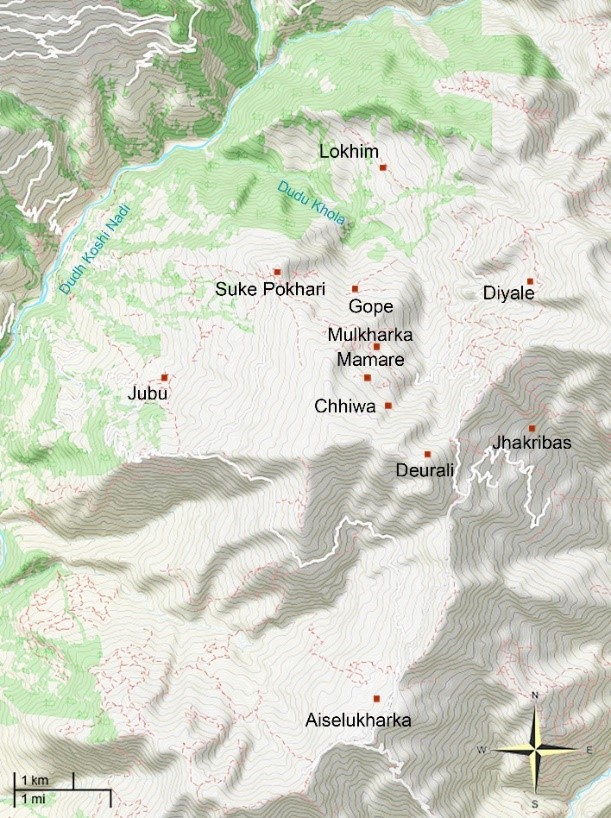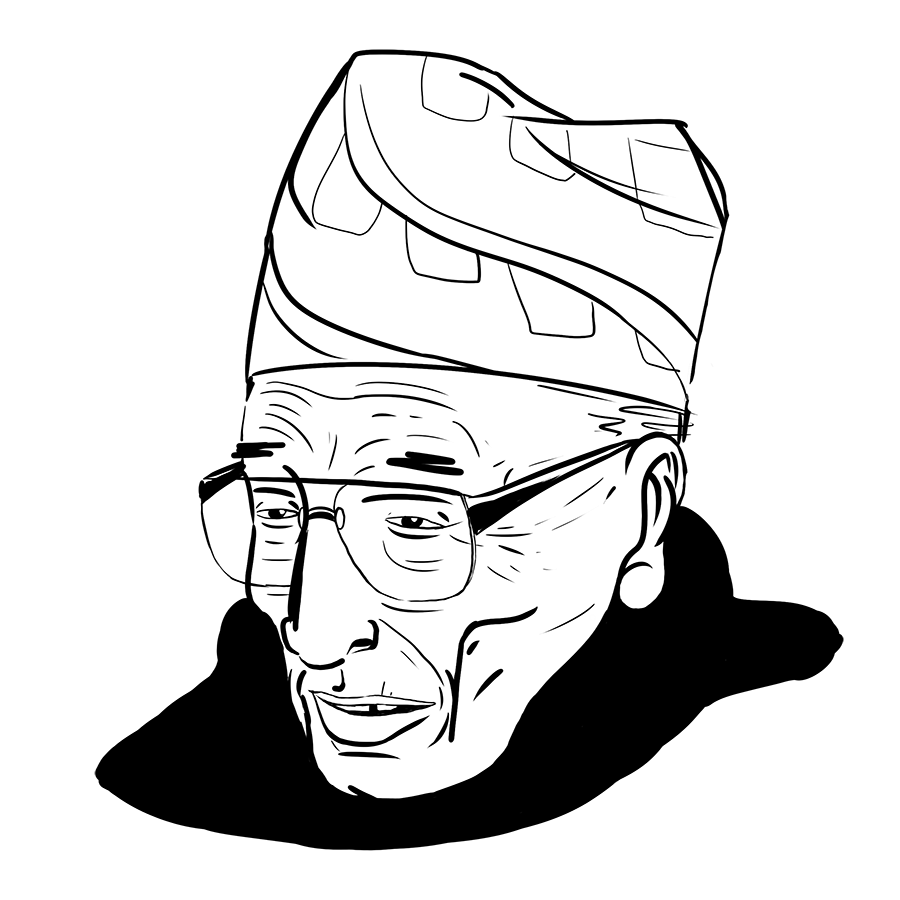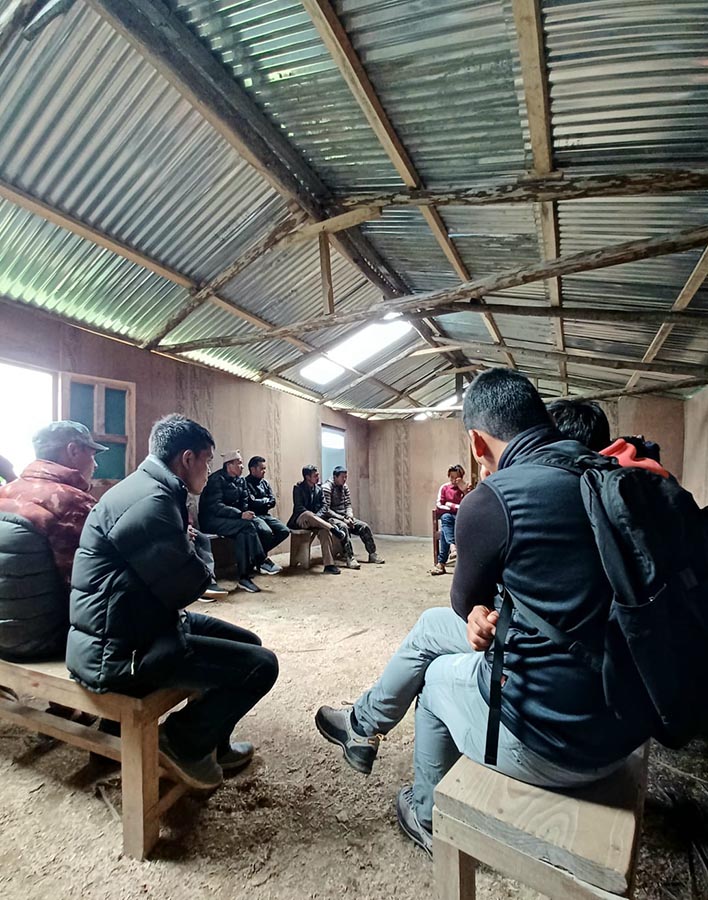Chimerical Emancipation: The Road to a Better Future in Nepal
The last decade has seen many significant political changes in Nepal. These came with promises of better lives and infrastructural and industrial development. But in Solukhumbu district, the inhabitants of a small Tamang village are still waiting for the roads to be built. Overcoming a feeling of powerlessness, they have decided to take matters into their own hands. By presenting one of their own in local elections, they decided to help shape a new horizon. These developments reveal how much infrastructure projects are embedded in local politics and the historical context of place.
Paths of yesteryear, roads of today
Before the road was built in Chhiwa, 1 in the south of the Solukhumbu district, the Tamang 2 inhabitants used the same paths their ancestors used before them, paths leading to the various bazaars (markets) in the area [Fig. 1]. To the west is the Lokhim market, and to the southeast, over the Deurali ridge that follows the border with Khotang district, is the path to Gope, Mulkharka, and Sukhe Pokhari [Fig. 2]. Twenty-five years ago, these roads were the main arteries of economic and social life. The incessant walking that characterised the daily life of the Nepalese working classes was part of the Nepalese ethos and can be found in a large number of ancient and contemporary songs and poems. Indeed, many well-known Nepali poems express a relationship with movement, such as Bhupi Sherchan’s Asāra (असार, “June”), written in the 1950s, which evokes the return to the village of those who have migrated to work. In the poem, rhymes, assonance, and onomatopoeia make palpable this link between the labouring body and the natural world through which men move. Nowadays, this “on foot” way of life is changing due to the rise of infrastructure development projects. Since 2017, the government has conferred a large degree of autonomy on rural municipalities, giving villages unprecedented power to launch projects. Federalism has given ward chairmen new tools, which they are gradually putting to use.

Fig. 2: Location of Chhiwa
and surrounding area.
Once elected, the Rai 3 ward chairman of Lokhim embarked on several projects, including the construction of several kilometres of roads, combining the municipality’s funds with a request for financing from the Koshi Province. After assessing the needs of his people, he ordered the creation of a road connecting Chhiwa to the Deurali ridge, accessible by motorised transport from other towns. The aim of the project was, firstly, to reduce the daily suffering of local residents who regularly walk all day to carry out their tasks, and secondly, to enable the development of new livelihoods.
One day, a friend and assistant of mine in Chhiwa introduced me to his eighty-year-old uncle (आस्याङ, āshyang) named Harka [Fig. 3], who started telling me a story about an infamous former local despot. It is the story of a kitchenware merchant (भामँडा, bhām̐ḍā) who came from Bhojpur district to marry a local woman, and who got elected head of the village assembly in 1976 and reigned over a village complex called Bakachol (Chhiwa, Mamare, Gope, Jhakri Bas, etc.) until 2006. 4 This man profited handsomely from the free labour of the surrounding Tamang for many years, in what appears to be a form of serfdom in Nepal’s pseudo-democratic Panchāyat (पंचायत, “village assembly”) era (1961-1990). When people came up from the valley over the ridge to the bazaars, they were repeatedly asked for free services in threatening ways. In return, the “kitchenware merchant” (as people continued to call him) was supposed to feed them, which he failed to do.

Fig. 3: Portrait of Harka, Adrien Vivière,
digital drawing, 8.25 x 8.25 inches,
2023, Bordeaux (France).
This situation lasted 33 years, as Harka recalled it, and was a fairly common form of forced labour that often consisted of porterage in exchange for rakam (रकम, “land tenure rights”). 5 However, all forms of land tenure rights had been officially banned in 1963. The old man continued: “All the Tamang, those from Chhiwa, Mamare, Jhakri Bas, worked for him. How did he use them? They did not agree at first when he asked them to work for free, but when he conquered the position of head of the village assembly, he started discriminating against all the Tamang [...]. He would say to all the people from Bagur, Mamare, Chhiwa, etc., ‘If you bring me stuff from Aiselukharka, I will make you tea and cook good food for you.’ But oh oh oh… the tea was never ready and he would say, ‘Oh next time, sorry, I didn’t have time.’ I used to go to his house too and we were afraid of him...”
In his retelling of these events, Harka conveyed his frustration with the situation. While the head of the village assembly was also doing some good for the community, he was obviously exploiting people with impunity: “He was very rich, looked very rich. One day, on a Saturday, I was going to the bazaar with my bag to buy some things and I came across several Tamang from Mamare, Chhiwa, and Bagur who were bringing back some things for him. I asked them, ‘Why do you still agree to work for the kitchenware merchant?’ They said, ‘If we don’t work for him, we are not allowed to take the path to the ridge, he will kill us, what can we do?’”
This story exemplifies how much the history of the path linking Chhiwa to various economic centres and bazaars is embedded in past power relations. Today, for the villagers, its transformation into a road suitable for motorised vehicles is important not just economically but also socially and symbolically.
Election promises and disappointments
In the local elections of 2017, a young Rai Maoist, a man named Bhupal, was elected ward chairman of Lokhim. His constituency was made up of numerous village units that were far apart and did not all have the same services. His stated aim was to improve the lives of all his constituents. A year and a half later, in the winter of 2019, as his Tamang opponent was gaining traction among Chhiwa’s inhabitants, he decided to start the construction of a road. He could see that the residents wanted rapid improvements following elections that had not been held for years. This new road would connect Chhiwa to the ridge for easier access to the town of Aiselukharka, another municipality where the inhabitants of Chhiwa go to buy food and petrol, among other supplies, or to go to the hospital.
As the full moon and the preparation for ancestor of the house rituals (दिमनि लाह पूजा, dimni lah pujā) approached, people conversed while sitting on their front porches. Conversations about the upcoming construction of the road and the chairman’s actions were on everyone’s lips. More than a political visionary, the new young ward chairman became a road project manager, the paragon of development. Election often resets residents’ expectations and hopes for “development” (विकास, vikās) that never happens. Supporters of the opposing camps, represented by the Unified Marxist Leninist party (UML) and Nepali Congress (NC) candidates, seized every opportunity to discredit the chairman’s policies.
Chhiwa’s inhabitants are for the most part svatantra (स्वतन्त्र, “free from any political affiliation”). They often say politicians in general are not to be trusted and are mere opportunists (अवसरवादि, avasaravādī). Yet, they have a different view of the Tamang candidate, Sun Kumar Tamang, for whom they voted in large numbers. A social worker in his forties who lives in the neighbouring town of Gope (where people support the road construction project), he became the unaffiliated candidate with almost no financial resources, and he and his constituents remained cautious about allegiances.
The construction of the road, an infrastructure project commissioned by the Maoist ward chairman, generated a complex set of reactions among the villagers. At first, they were enthusiastic about the idea of change, and the Maoist party was well-liked in the village. Then broken promises started feeding growing suspicion and discontent. Aware of the lack of support for his candidacy from the people of Chhiwa during the last election and hoping to increase the villagers’ participation (सहभागि, sahabhāgī) in political life, the chairman delegated part of the project management to the villagers. Several young people joined a “road committee” and became responsible for project monitoring. Villagers expressed their concerns about the conditions of their involvement, however – NGOs and public authorities have made a habit of requesting free collective work from the beneficiaries of development projects when such projects should promote employment opportunities instead. And unlike in the past, they also expressed their desire to influence the way work was carried out, although the engineers still had the final say.

Fig. 4: Bulldozer on the road to Deurali.
In early 2020, bulldozers started to dig what was to become the road from Chhiwa to the Deurali ridge [Fig. 4]. The road, a symbol of present and future wealth, generated fantasies and desires as soon as work began, exemplary of a kind of “infrastructural fetishism.” 6 The work began awkwardly without anyone knowing who was doing what. Surveyors, civil servants, bulldozer drivers, and officials all came and went to and from the site. Soon, the opacity and lack of transparency (पारदर्शिता, pāradarśitā) that characterises this kind of project created tensions and generated rumours. Some were accused of corruption (भ्रष्टाचार, bhraṣṭācāra), which is present throughout the country, though generally invoked by those who feel wronged. Authorities could not guarantee the road’s completion, and construction slowed to a halt during the Covid pandemic. At the time, conversations on Facebook provided fertile ground for investigation into inhabitants’ sentiments. The ward chairman, himself very active on social media, started receiving negative comments from various residents: “Bhupal has sabotaged himself in five years! Even if Bhupal wins again, nothing will happen! What has he done for Lokhim in the last few years? The people of Lokhim must understand. Politics is service [to the people], not selfishness!” 7
Sensing the lack of local support, Bhupal left the Maoist Party to join the UML and run for a different position in the next election. Sun Kumar, a Tamang social worker, ended up as the new Maoist Party candidate for the Ward No. 9 Lokhim elections in December 2021. The road was not yet bringing the “development” for which the people had hoped, and the outgoing ward chairman’s uneven record awakened distrust and generated slander. Six months later (in May 2022), Sun Kumar was finally elected. Some Chhiwa residents were on the electoral list, so they became his assistants and took over the construction of the road [Fig. 5].

Fig. 5: Local meeting before
the 2022 election.
A horizon of opportunity and the melancholy of return
Between the old story of the kitchenware merchant despot and the recent election of a Tamang candidate, we can see signs of a slow evolution in the integration of the Tamang into the representative bodies of political power, and ultimately a change in class relations. In this region, the dominant class historically has long been that of the Newar merchants. Today, the Kirat populations, and particularly the Rai, are involved in ethnic movements that actively contribute to reshaping inter-ethnic power relations. The Tamang minority, for their part, are still struggling to find their place.
While this evolution is slow-paced, the inhabitants of Chhiwa remain convinced that a road would improve their daily lives. The anthropologist Dimitri Dalakoglou writes that “the majority of people understand how infrastructures are foundational systems of reference for the entire society,” 8 but what road construction actually helps create is often implicit and left to interpretation. In Chhiwa, social relations are part of a coherent social and symbolic system in which sharing is the rule and individualistic impulses without redistribution are frowned upon. The prospect of a motorable road reinforces the ideology of progress and generates desires, imaginaries, and fantasies about a different life far from home. Many talk about leaving the village, an individual choice that makes it possible to seize potential economic opportunities.
Almost all young people in Chhiwa want to take the road in one direction or the other: to go north, where the Sherpas have made their fortune in the Everest region as porters or guides; or to go to Kathmandu, a city that represents wealth but where life is not always easier than in the village. With no straightforward path to follow when they leave the reassuring social sphere of the village, they often conform despite themselves to a pattern of social reproduction of marginality.
The road is a symbol of departure but also of return. Men build roads to get out of the village and travel to where they can generate income. The young people of Chhiwa have taken the opportunity offered by the road to extract themselves from the village-level sphere of social relations and mutual obligations, but the social world to which this road has given them access also generates a “desire to return.” For some who have been away for many years, a good road actually makes it possible to return to the village. As a young man from Chhiwa, now a resident of the Kapan district in northeast Kathmandu, told me: “As soon as the roads are good, I will return to Chhiwa [to live].” For those who have been living in Kathmandu or elsewhere for years, returning to the village when they “have money” and the road is finished is a good idea. They are nostalgic for the return to their lost country.
As historian Rudolf Mrázek points out, “infrastructure creates a sense of modernity that passes through the body and mind, the sight of a long, straight, smooth road produces a sensory and political experience.” 9 Many think of their return home as a straight and smooth one. But what kind of experience will they be bringing back with them? Once in Kathmandu, their experience of modernity is often confusing and disappointing. In Chhiwa, construction of roads takes time and money; it is a bumpy process of negotiation that needs to be continuously renewed and is not always successful. If it produces a kind of sensory, emotional, and political experience, it also often generates a sense of disillusionment and powerlessness. This experience does not give politics a revolutionary aura for the young villagers to whom I spoke, nor does it determine ideologies or political labels. In fact, through this experience, they come to realise the value of kinship ties and social relations back in the village. Distrustful of party politics, they vote for people they know well and trust.
Conclusion
By definition, the horizon is a line where the earth and sky meet at the edge of the visual field, and it is always pushed back as the viewer moves forward, never attainable. In political language, the horizon designates a desirable future to be built together. Political party leaders in Nepal often use this imagery to explain their political programs. The inhabitants, however, sensing that the politicians’ promises will be difficult to keep, are now saying that they vote “more for the person (ब्याक्ति, byākti) than for the Party.”
The construction of the road in Chhiwa is embedded in a local history of relations and does not modify the deep social structures that underpin Tamang relationships with the rest of Nepalese society. The political evolution and the increased power conferred on the rural municipalities were, however, crucial to the development of infrastructural projects. As anthropologist Ben Campbell argued a decade ago, “it is an old rhetoric of modernisation that thinks a rural and ethnically marginal population can be brought into modern economic ways and opportunities through simply providing infrastructural connection.” 10 The building of a road contributes to the construction of the political subject in several ways. In the particular social situation of road construction, a series of social phenomena and conflicts are at play which reinforce the subject’s awareness of being marginalised and distant from circles of power. The social order of a village like Chhiwa, which does not attract a lot of tourists, is rarely shaken up and old class and hierarchical relationships persist.
What the poorly completed road construction project produces in this small Tamang village is a feeling of “stagnation.” Generally speaking, the decentralisation of federalism and the hyper-centralisation of political parties has not promoted the advent of “tribal” (जनजाति, janajātī) representatives in power. 11 The people of Chhiwa have partly solved this problem by nominating and then electing “one of their own” to the position of ward chairman in 2022. But when that happens, what difference does it make? This victory did not prevent more villagers from leaving for other horizons. Movement is still the best way to fight stagnation, and perhaps that is why young people, faced with so many difficulties, leave the village, abandoning local politics while at the same time reinforcing the idea of a liberating mobility.
Florent Grazide is a doctoral student and lecturer at the University of Bordeaux, affiliated with the PASSAGES research laboratory (CNRS UMR 5319). He studied Nepali at INALCO (Paris) and is doing research in Nepal on local politics, ethnicity, ethnohistory, youth, and identity movement among the Tamang. Email: florent.grazide@protonmail.com